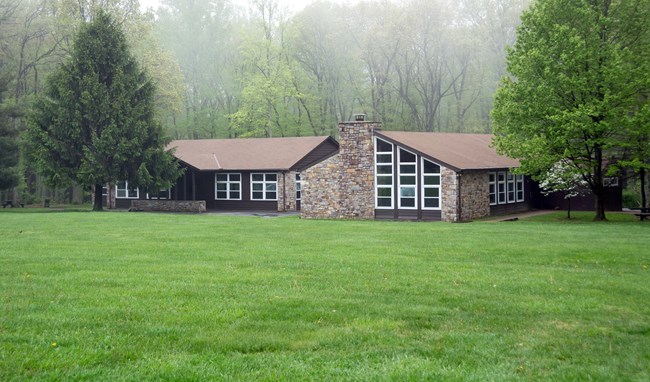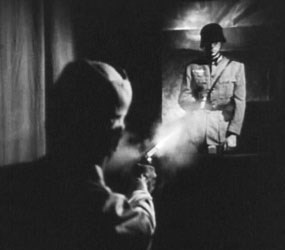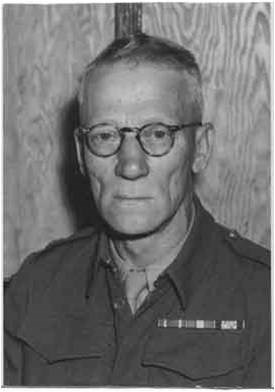
Volunteer John Zuke In the field in front of the mess hall at B-2 there were several pieces of training equipment. There were ropes for hand-over-hand climbing, and a football tackling dummy. An 8-foot wooden platform was erected over a sand pit. This piece of equipment was used to practice parachute jumping and landing. Several large open saw-dust filled pits were used to practice close combat exercises such as ju-jitsu, wrestling, and knife fighting. One of the executive officers designed a piece of equipment that was called the “Trainazium.” It was constructed from a dozen large oak trees approximately 15 to 18 inches in diameter. The trees were harvested from within the Catoctin Recreational Demonstration Area much to the dismay of Park Manager Mike Williams. Underneath the 18-foot tall structure, safety nets were installed to catch fallen trainees. The recruits learned to maneuver and walk in narrow spaces, allowing for improved strength and dexterity. The 20 ft. x 20 ft. rectangular structure was located in front of the mess hall in B-2. Transcript
This outdoor trainazium was carefully constructed to develop muscles most used in individual close combat. In fact, the first principle of commando, or guerrilla training, evolves from the theory that the best defense is a good offense. Hit first and talk afterwards. In short, get tough. And, in the business of getting tough, there is certainly no better
Visit our keyboard shortcuts docs for details
Actual footage from OSS training videos produced by John Ford. 
NARA The House of HorrorsA pistol range was initially constructed at B-2 for firing .45 Colt automatic and other pistols. The range had pop-up targets of enemy soldiers. Students were instructed how to fire a pistol using a special quick firing method from the hip called "Point and Shoot." Another unique Office of Strategic Services (OSS) training structure at B-2 was the "Pistol House." It was also known as the "Mystery House," "House of Horrors," and the "Haunted House." At a cost of $6,000 it was the most expensive structure built by the OSS. The house was located where the stable is today in Camp Greentop. It was designed by British Special Operations to teach close shooting practice under realistic conditions. Trainees were sent into the house with an instructor and were armed with a .45 automatic pistol. The house simulated a building that was occupied by Nazis and the interior was kept completely dark. The floors in the house were unstable and included frequent drops. There was a hidden phonograph that played realistic sounds including men speaking German. As they moved through the house they encountered Papier-Mâché Nazis with pistols. Transcript
After a few weeks of preliminary training, the student is told report alone to the pistol house, a mysterious structure he has never before entered. In the anteroom, the instructor gives him his problem. A group of enemy saboteurs are active in the neighborhood taking a heavy toll of life and property. The student is to make contact and to maintain it until either he or the enemy is wiped out. Whispering. Alright, here we go now, now watch your step on these stairs. Look out for that corner. That's it. Alright up now. Easy does it. Keep coming. Now, watch yourself down here. Eyes open. That's it. Okay. Down the stairs again. Up on that roof and watch it. Don't lose your footing. Keep coming. That's right. Alright, let's go. Now, keep moving. Look out! Get him! Sound of gun shots. That's it. Good boy! Alright. Down this passage now. Watch your step. That's it. Look out for this corner! Down low. Get your gun out. There. Alright, all clear. Go ahead. Take it easy now. Look out for this. Quiet now. That's it. Okay. Keep your eyes open. Sound of door slamming open and gun shots. That's it. There are more of them around here. Alright, look out for this corner. There we are. There's a door. Alright now, kick the door down and when you do, get him! Sound of kicking the door and gun shots. That's right. Look out for this flooring. It's bad. Don't fall now. Keep moving. Look out for that guy. Keep your eyes open for him. Watch him! He's there someplace. Sound of gun shots. That's right. There are more of them around here, so don't relax. Look around. There's one! Sound of gun shots. Another one! That's right. Sound of gun shots. Alright, quickly now. Magazine in. Test it. Alright, let's go. Sound of gun shots.
Visit our keyboard shortcuts docs for details
Actual footage from OSS training videos produced by John Ford. 
Press Association, Inc. Get ToughOne instructor of special note on loan from the British government was William “Fearless Dan” Fairbairn. The former British official instructed agents on hand-to-hand combat techniques. His form of “gutter fighting,” later known as the “Fairbairn Technique,” was a combination of ju-jitsu and street fighting. He was an expert in disarming the enemy and “silent” killing techniques. OSS agents favored his specially designed double-edged dagger. In his 50s, Fairbairn is seen in several OSS instructional films training recruits at B-2. Transcript
There are no Marquess of Queensberry rules in guerrilla warfare. It's a simple matter of kill, or be killed, capture, or be captured. In this phase of the instruction period, the student is taught the gentle art of murder. The technique of killing or crippling his opponent with his two hands at close quarters. The success of this system of close combat has little to do with size or strength. The larger man here should have little trouble tossing the smaller one around, yet, by the pressure of one finger in the right spot, he is rendered powerless. The same theory applies to all the holds in this course. Most valuable offensive blow at close quarters is the chin jab. The hand is held open at shoulder height and the blow is delivered to the opponent's chin with all the weight of the body in the follow-through. Another excellent weapon is the edge of the hand. Keep the fingers tight together, thumb erect. The blow is a sharp slash with follow through. Apart from the commando knife, which is considered in the later part in the training course, there are several hand weapons of inestimable value in guerrilla warfare. One of these is the kosh, spelled kosh. The hitting end is a lead weight which telescopes into a small cylinder secured up the sleeve by a wrist tong. In preparing for action, the cylinder is dropped into the palm of the hand and the actual blow is delivered as a sidearm throw. Centrifugal force drives the lead weight out to the end of the spring. A properly delivered blow to the side of the head will cause a skull fracture and possibly death. The smatchet is a heavy knife of extreme killing power, beautifully balanced and capable of lethal action either with the point, blade or pommel. The derringer, a tiny single-shot pistol which can be concealed in the palm of the hand, or up the sleeve may be the difference between life and death in an emergency. Most methods of disarming are equally applicable to all types of side arms, but the following are believed to be better adapted to use against the revolver. Here is the simplest defense of all, a quick blow with the edge of the hand across the wrist possibly breaking it. Another disarm from the front: Seize the wrist in one hand and with the other, twist the pistol against your opponent's fingers. In some cases, this maneuver works better: grab the a gun in one hand strike the wrist sharply with the other, at the same time pulling the weapon free. A very simple and effective means of reducing the homicide rate when revolvers are used. Merely touch the cylinder and hold it securely. As long as the cylinder can't turn, the gun can't fire. This is not a good idea if the gun is cocked or of the single action variety.
Visit our keyboard shortcuts docs for details
Actual footage from OSS training videos produced by John Ford. 
Next article: Field Testing Agents -->Office of Strategic Services History |
Last updated: May 7, 2020
